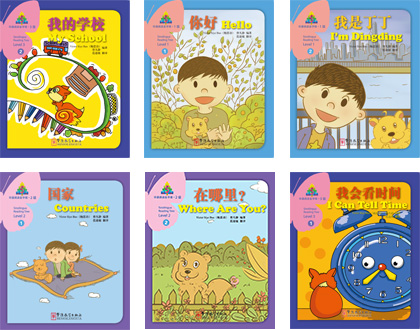 The Sinolingua Reading Tree series is a collection of graded Chinese storybooks. It is tailored for elementary school students from both regular and dual language immersion schools.
The Sinolingua Reading Tree series is a collection of graded Chinese storybooks. It is tailored for elementary school students from both regular and dual language immersion schools.
Each level of the series is designed for students of grade K, 1 and 2 respectively as a supplemental program. In line with Idaho Content Standards, it intends to support comprehensive textbooks and provide students with various opportunities to engage in Interpretive Reading, Interpersonal Communication and Presentational Speaking with culturally appropriate materials. The program also includes exercises for young students to learn the very basics of writing Chinese characters.
Each level of the series offers a set of 10 simple yet exciting storybooks on a variety of topics roughly following the order of self – family – school - community. For example, Level 1 includes topics on greetings, self-introductions, family members. Level 2 includes topics on nation, location, times, dates, likes and dislikes. Level 3 includes topics on birthday, school, shopping.
Each book includes a main Story, a Vocabulary Chart, a Chinese–English page, and Activities.
--Teachers could read to students the main story at first in order to engage students and meanwhile demonstrate the right pronunciations. Then students could retell or paraphrase the story using pictures as a guide.
--The Vocabulary Chart ensures students to become familiar with Chinese characters and develop their pronunciation and reading fluency.
--Chinese-English page helps give students a better understanding of the story and the vocabulary. This page can be removed for immersion schools students.
--Each book is followed by two activities. Tracing the Characters and Coloring the Picture allow students to learn the basics of Chinese characters, preparing them to learn how to write, and all the while increasing the entertainment value of the book.
Best Practices in Program Design:
--Learning style/structure:
1) Interactive learning: Reading aloud, role playing, class games using the materials, pairing students up or grouping them up for various activities applying the materials.
2) Each book is structured with a Story, a Vocabulary Cart, Activities and Chinese-English page.
--Pedagogical practice:
1) Task based learning: Design tasks with the reading materials and assign students to accomplish the tasks.
2) Thematic learning: Group materials into themes and allow students to learn by centering the materials around various themes.
--Assessment: Exercises in the back of each book assess student performance in reading comprehension, speaking and writing. Teachers could also conduct assessment through games and activities.
--Engagement: Repeated practice and activities based on the story themes foster more student engagement.

